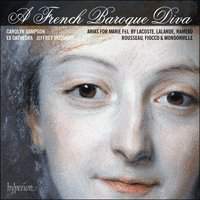Texte paru dans: / Appeared in: |
|
|
|
|
|
Reviewer: Barry
Brenesal Here’s a coherent program, though functioning more as a showcase for Carolyn Sampson than as musical survey or analysis. The subject is soprano Maria Fel (1713–1794), and 18 of its 22 selections were performed by her at the Paris Opéra and Concert Spirtuel between 1734 and 1769. (The outliers are three pieces from Delalande’s 1707 Cantate Domino and one from his 1706 Exsurgat Deus.) Judging from these airs and scenes, she was the equivalent in at least some sense of a modern, extremely agile lyric. She apparently was a performer with quite an expressive range, from the pathos of Vénus in Lacoste’s Philomèle to the extravagant silliness of La Folie in Rameau’s Platée. She could easily handle the coloratura in Mondonville’s praise of birdsong in Daphnis et Alcimadre, and made the most of a simple, dangerously exposed line in a selection from the same composer’s Venite, exsultemus—one suspects through tonal beauty, enunciation, and breath support. Back in a 2004 Fanfare review of love songs from Rameau operas (Hyperion 67447) I praised Carolyn Sampson for the quality of her “flicker-fast vibrato,” and in Handel’s Parnasso in Festa (Hyperion 67701/2), noted she “has the most attractive voice in the cast, slender but rich in overtones, and used with consummate artistry….” Much the same can be said of this release. The voice lacks plushness, but there’s a gleaming top, excellent shading, a fine handling of coloratura, and a bit more richness to the lower register. The shading and richness both figure into the aria from the aforementioned Philomèle (with the choral forces of Ex Cathedra in fine form), while her agility figures heavily in the Mondonville air, and selections from Fiocco’s Laudate pueri. Excerpts from act II of Rameau’s Les surprises del d’Amour provide an interesting comparison. What I’d hoped for was a version of Uranie’s dramatic scene “C’est ici le séjour,” but what we actually get is a skeletal framework formed out of sections from three scenes involving Parthénope. Though Skidmore utilizes the 1754 edition and the complete recording under d’Hérin (Glossa 922701) that of 1757, both feature the latter Muse’s air, “Écoutons … D’un doux frémissement.” The singing makes for interesting comparison. D’Hérin’s soloist, Karine Deshayes, is just as accurate in the many ornaments as Sampson, but warmer-voiced; while Sampson’s narrow, silvery tone lends an air of fragility to hers. Skidmore plays this up with greater flexibility in accompaniment. It must be said that Deshayes enunciates better here, and that Sampson, for all her remarkable shading in Venite, exsultemus, is next to impossible to understand. But when she isn’t engaged in spinning out a line or a figure through vowels, she makes much of the text. Her performance of the recitative “Un tendre intéret vous appelle” and its famous aria, “Tristes apprets” from Castor et Pollux is all one could ask for in this respect: attentive to word and musical values in specific and detail, within the framework of Telaïre’s tragic situation. That lack of plush I mentioned earlier still makes itself felt towards the end of the aria, but it’s a minor irritant when placed against Sampson’s studious but never studied assumption of the role. Much more of the same would be welcome, especially when accompanied by Skidmore, a scholar who has all the instincts of a first-rate opera conductor. Factor in texts and translations, and you have a highly recommendable disc. | |
|
|
|
|
|
|
|
Cliquez l'un ou l'autre
bouton pour découvrir bien d'autres critiques de CD |
|




